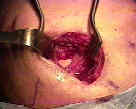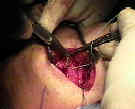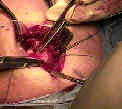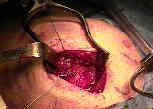- if cuff is not repairable, then debride the tendon edges, it remove any further source of impingement;
- bony trough:
- classically an osteotome is used to create a 4-5 mm wide and 25 mm long in the space between greater tuberosity and articular surface;
- the trough should usually begin just lateral to the biceps tendon;
- in the study by Boileau et al, the authors advocated abrasion of the upper surface of the greater tuberosity w/ a burr, removing all soft
tissue and cortical bone, to create a bleeding cancellous bone bed;
- references:
- Healing of bone-tendon junction in a bone trough: a goat partial patellectomy model.
- Arthroscopic repair of full-thickness tears of the supraspinatus: does the tendon really heal?
- transosseous hole technique:
- tendon suture technique:
- Becker suture technique:
- has been studied extensively for flexor and extensor tendon lacerations in the hand;
- in the study by Singer, et al (1998), the core suture technique was the most important element in establishing both strength and stiffness of the repair;
- repair consists of criss-crossing running suture using a double armed needle;
- sutures should be placed 0.75 cm from the cut edge of the tendon;
- as noted in the report by Howard, et al (1997), the MGH tendon repair technique (crossing running
suture repair) was signficantly more resistant to gap formation than the Bunnel or the Krackow technique;
- references:
Biomechanical analysis of four-strand extensor tendon repair techniques
Use of the Taguchi method for biomechanical comparison of flexor-tendon-repair techniques to allow immediate active flexion.
- MGH tendon repair has superior suture purchase which is probably related to superior resistance to gap formation;
- Modified Mason Allen technique:
- has been shown to be superior to simple stitch in an experimental animal model study;
- reference:
- Experimental Rotator Cuff Repair. A Preliminary Study.
- trans-osseous holes:
- as noted by Caldwell, et al, (1997) and Gerber, et al (1999), the strength to failure was greater when:
- sutures were placed at least 10 mm distal to the greater trochanter;
- sutures were tied over a bone bridge at least 10 mm in length;
- use of a plastic button in osteoporotic bone may help prevent failure at the bone suture interface;
- some authors advocate distal placement of the transosseous holes, inorder to stay well away from soft metaphyseal bone;
- references:
- Experimental Rotator Cuff Repair. A Preliminary Study.
- Strength of fixation with transosseous sutures in rotator cuff repair.
- Cyclic loading of transosseous rotator cuff repairs: tension overload as a possible cause of failure.
- Tendon-to-Bone Pressure Distributions at a Repaired RC Footprint Using Transosseous Suture and Suture Anchor Fixation Techniques.
- tying down the sutures:
- in suturing debrided edge of rotator cuff tissue to freshened bone or reattaching deltoid to bleeding acromial bone edge, surgeon
should passively elevate the arm while sutures are tied;
- this avoids undue tension from sutures on soft tissues & bone if sutures are placed through holes in bone;
- it also permits easy tissue approximation and avoids weakening of suture material when it is pulled taut
The Multi-suture Technique for Rotator Cuff Repair: A Biomechanical Evaluation
Arthroscopic Transhumeral Rotator Cuff Repair: Giant Needle Technique
Arthroscopic Transosseous Rotator Cuff Repair
Transosseous arthroscopic repair of partial articular-surface supraspinatus tendon tears
Arthroscopic transosseous (anchorless) rotator cuff repair
Biomechanical Evaluation of Transosseous Rotator Cuff Repair. Do Anchors Really Matter?





